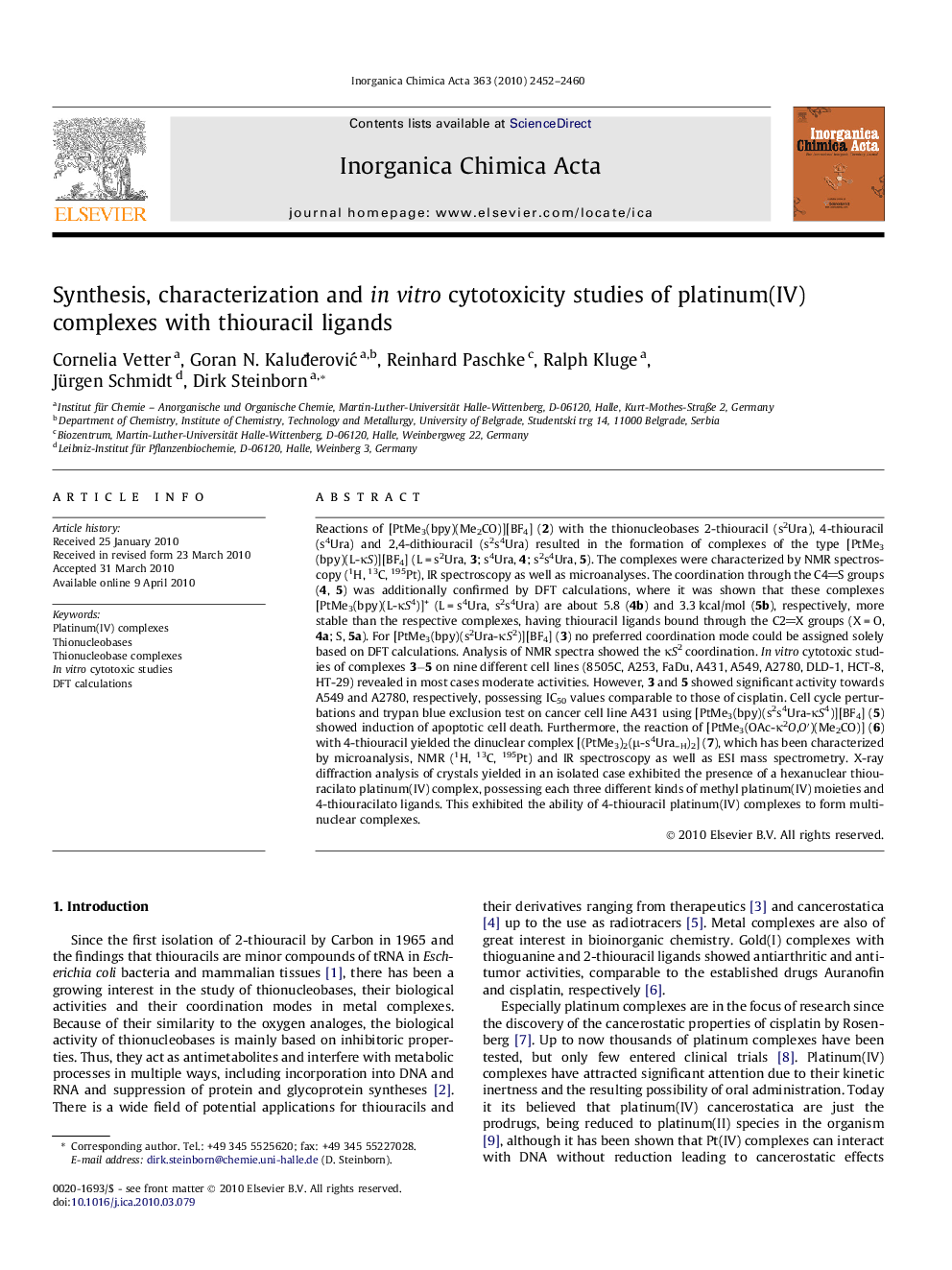| کد مقاله | کد نشریه | سال انتشار | مقاله انگلیسی | نسخه تمام متن |
|---|---|---|---|---|
| 1308001 | 975161 | 2010 | 9 صفحه PDF | دانلود رایگان |

Reactions of [PtMe3(bpy)(Me2CO)][BF4] (2) with the thionucleobases 2-thiouracil (s2Ura), 4-thiouracil (s4Ura) and 2,4-dithiouracil (s2s4Ura) resulted in the formation of complexes of the type [PtMe3(bpy)(L-κS)][BF4] (L = s2Ura, 3; s4Ura, 4; s2s4Ura, 5). The complexes were characterized by NMR spectroscopy (1H, 13C, 195Pt), IR spectroscopy as well as microanalyses. The coordination through the C4S groups (4, 5) was additionally confirmed by DFT calculations, where it was shown that these complexes [PtMe3(bpy)(L-κS4)]+ (L = s4Ura, s2s4Ura) are about 5.8 (4b) and 3.3 kcal/mol (5b), respectively, more stable than the respective complexes, having thiouracil ligands bound through the C2X groups (X = O, 4a; S, 5a). For [PtMe3(bpy)(s2Ura-κS2)][BF4] (3) no preferred coordination mode could be assigned solely based on DFT calculations. Analysis of NMR spectra showed the κS2 coordination. In vitro cytotoxic studies of complexes 3−5 on nine different cell lines (8505C, A253, FaDu, A431, A549, A2780, DLD-1, HCT-8, HT-29) revealed in most cases moderate activities. However, 3 and 5 showed significant activity towards A549 and A2780, respectively, possessing IC50 values comparable to those of cisplatin. Cell cycle perturbations and trypan blue exclusion test on cancer cell line A431 using [PtMe3(bpy)(s2s4Ura-κS4)][BF4] (5) showed induction of apoptotic cell death. Furthermore, the reaction of [PtMe3(OAc-κ2O,O′)(Me2CO)] (6) with 4-thiouracil yielded the dinuclear complex [(PtMe3)2(μ-s4Ura–H)2] (7), which has been characterized by microanalysis, NMR (1H, 13C, 195Pt) and IR spectroscopy as well as ESI mass spectrometry. X-ray diffraction analysis of crystals yielded in an isolated case exhibited the presence of a hexanuclear thiouracilato platinum(IV) complex, possessing each three different kinds of methyl platinum(IV) moieties and 4-thiouracilato ligands. This exhibited the ability of 4-thiouracil platinum(IV) complexes to form multinuclear complexes.
The reaction of [PtMe3(bpy)(Me2CO)][BF4] with the thionucleobases 2-thiouracil (s2Ura), 4-thiouracil (s4Ura) and 2,4-dithiouracil (s2s4Ura) resulted in the formation of complexes [PtMe3(bpy)(L-κS)][BF4] (L = s2Ura, s4Ura, s2s4Ura). The coordination mode (κS4: s4Ura, s2s4Ura; κS2: s2Ura) was established by NMR spectroscopic investigations and additionally confirmed by DFT calculations. Furthermore, [PtMe3(OAc-κ2O,O′)(Me2CO)] was found to react with 4-thiouracil yielding the dinuclear complex [(PtMe3)2(μ-s4Ura–H)2] having bound deprotonated 4-thiouracilato ligands. Cytotoxic studies revealed selective activities which are, in part, comparable to those of cisplatin. In a selected case cell cycle perturbations and a trypan blue exclusion test indicated the induction of apoptotic cell death.Figure optionsDownload as PowerPoint slide
Journal: Inorganica Chimica Acta - Volume 363, Issue 11, 10 August 2010, Pages 2452–2460